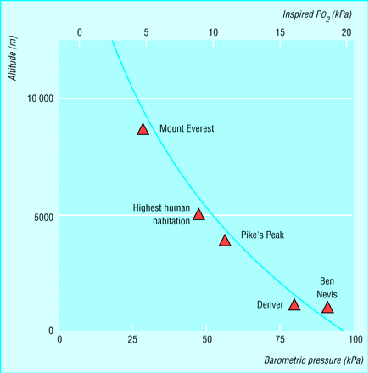
The top of Mount Everest sits in the upper troposphere, a part of the atmosphere where winds travelling at 110 km an hour can pummel climbers. This region is also affected by jet streaks, extra fast bursts of wind within the jet streams that race around the Earth from west to east. The mountaineers waited until a lull in the weather, and then began climbing to Everest's peak. But when a jet streak passed by shortly afterwards, the climbers found themselves in trouble.
Moore explains that these jet streaks can drag a huge draught of air up the side of the mountain, lowering the air pressure. He calculates that this typically reduces the partial pressure of oxygen in the air by about 6%, which translates to a 14% reduction in oxygen uptake for the climbers. Air at that altitude already contains only one third as much oxygen as sea-level air.

Very high altitudes can have serious, and deadly, effects on the human body.
Altitude itself is perhaps the greatest threat to the life of any high-altitude
climber. Atmospheric pressure decreases as altitude increases, and the
atmospheric pressure at the summit of Everest is 33% that of sea level.
Therefore, there is 66% less oxygen than there is at sea level. Kerosene will
not burn. Helicopters cannot fly. Yet somehow, your metabolism is able to
continue its chemical conversions inside of you, turning food into heat and
energy.
At high altitudes breathing becomes a task. Because there is so little oxygen,
your body must work harder to pass more air through your lungs. Yet your
increased breathing rate taxes your body of more energy. Altitude sickness
occurs most often when there is rapid ascent, and the body does not have
sufficient rest time at intermediate elevations to acclimatize. If a person were
flown to the top of Everest and released at the summit without oxygen, he or she
would die within an hour. Some ways that your body copes with lower oxygen
levels are increased production of red blood cells (which carry oxygen
throughout the body) and increased production of the enzymes that aid in the
release of oxygen to the tissues.
Graph- Copyright: www.bmj.com
Acute Mountain Sickness (AMS)
This is a commmon set of symptoms, easily hidden behind common daily ailments,
related to rapid ascent to high altitudes. Usually AMS is characterized by:
headache, dizziness, fatigue, dry cough, loss of appetite, nausea, vomiting,
disturbed sleep, and malaise.
High Altitude Cerebral Edema
This occurs in a small portion of people who are afflicted with AMS, usually
above 12,000 feet. Cerebral Edema is due to excessive accumulation of fluid in
the brain, and can cause death or permanent brain damage. Symptoms include:
unsteady gait, inability to perform minor daily tasks, confusion, loss of
memory, hallucinations, psychotic behavior, and coma.
High Altitude Pulmonary Edema
This, like Cerebral Edema, occurs along with AMS, but is the most dangerous of
the common types of altitude sickness. It can also lead to the development of
Cerebral Edema. If the afflicted becomes unconscious, descent or oxygen must be
administered within 6 to 12 hours or death is likely. Pulmonary Edema occurs
when the lungs fill with fluid, blocking the transfer of oxygen from inhaled air
to the red blood cells. Confusion and delerium are indicative of advanced cases.
Intrepid mountaineers usually start their ascent of the world's highest mountain from a base camp at about 5000 m, trekking to the South Col at a height of around 8000 m. From there it is a full day's climb to the summit at 8850 m.
On 8 May 1978, Reinhold Messner and Peter Habeler achieved the first ascent of Mount Everest without an oxygen supply. Since then, more and more climbers have opted to go to the highest place in the world without the support of oxygen cylinders. However if Professor Moore's theory is correct, and the partial pressure of oxygen drops then without an oxygen supply the mountaineer will not survive long.